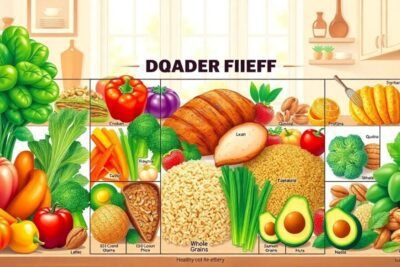
Diabetes friendly diet plan for optimal management
Adopting a diabetes friendly diet plan can be a transformative step for individuals managing diabetes. By understanding the principles of nutrition and meal planning, it's possible to maintain healthy blood glucose levels while enjoying a variety of foods.
This article explores effective strategies and practical tips to create a meal plan tailored for diabetes, focusing on nutrient-dense foods and portion control.
- How can a diabetes meal plan help you?
- What is a diabetes friendly diet plan?
- Why is a structured meal plan important for diabetics?
- What are healthy snacks for diabetics?
- How to use the diabetes plate for meal planning?
- What foods should be included in a diabetes diet?
- How to meal-prep for a week of diabetic meals?
- Related questions about diabetes meal planning
- Questions related to diabetes meal planning
How can a diabetes meal plan help you?
A well-structured diabetes meal plan serves as a roadmap for maintaining optimal blood glucose levels. By establishing regular meal times and incorporating balanced nutrients, individuals can better manage their diabetes. This approach not only helps in controlling blood sugar but also contributes to overall health.
When following a diabetes friendly diet plan, it is crucial to focus on healthy carbohydrates and appropriate portion sizes. This ensures a steady release of energy without causing spikes in blood glucose.
Moreover, a diabetes meal plan encourages the consumption of fiber-rich foods and lean proteins, which aid in digestion and provide essential nutrients. By prioritizing these elements, individuals can enhance their well-being while effectively managing their condition.
What is a diabetes friendly diet plan?
A diabetes friendly diet plan is designed to help individuals manage their blood sugar levels through balanced nutrition. This plan typically emphasizes whole, unprocessed foods that are low in added sugars and unhealthy fats.
Key components of a diabetes friendly diet include:
- Non-starchy vegetables: Fill half your plate with a variety of colorful veggies.
- Lean proteins: Incorporate options like chicken, fish, or legumes.
- Whole grains: Opt for brown rice, quinoa, or whole grain bread.
- Healthy fats: Include sources like avocados, nuts, and olive oil.
By adhering to these guidelines, individuals can create meals that are satisfying and align with their health goals. This approach not only promotes stable blood glucose levels but also supports long-term health.
Why is a structured meal plan important for diabetics?
A structured meal plan is vital for individuals with diabetes as it provides clarity on what, when, and how much to eat. This structure helps in minimizing the risk of hyperglycemia and hypoglycemia. Furthermore, it allows for better tracking of carbohydrate intake, which is essential for effective blood sugar management.
One effective method for structuring meals is the use of the Diabetes Plate, which simplifies the process of meal planning. By dividing the plate into portions—half for non-starchy vegetables, a quarter for lean protein, and a quarter for healthy carbohydrates—individuals can easily visualize balanced meals.
Additionally, a structured meal plan can assist in developing healthy eating habits, making it easier to resist temptations and choose foods that support overall health.
What are healthy snacks for diabetics?
Healthy snacking is an important aspect of a diabetes friendly diet plan. Choosing nutrient-dense snacks can help maintain energy levels and prevent drastic blood sugar fluctuations. Here are some excellent options:
- Fresh fruit: Pairing apples or berries with a handful of nuts provides fiber and healthy fats.
- Vegetable sticks: Carrot or cucumber with hummus makes a satisfying and nutritious snack.
- Greek yogurt: Opt for plain, low-fat yogurt topped with seeds or nuts.
Incorporating these snacks between meals can help control hunger and provide essential nutrients, contributing to better blood glucose management.
How to use the diabetes plate for meal planning?
The Diabetes Plate method is a straightforward way to plan meals without the need for extensive measurement. To use this method effectively, follow these steps:
- Begin by visualizing your plate and dividing it into three sections.
- Fill half of the plate with non-starchy vegetables like spinach, broccoli, or bell peppers.
- In one-quarter of the plate, add a lean protein source, such as grilled chicken or tofu.
- In the remaining quarter, include a serving of healthy carbohydrates, such as quinoa or sweet potato.
This approach helps ensure that meals are balanced and nutrient-dense, making it easier to maintain stable blood glucose levels.
What foods should be included in a diabetes diet?
A diabetes diet should focus on nutrient-dense foods that promote overall health. Some key food groups to include are:
- Fruits and vegetables: Aim for a variety of colors and types to maximize nutrient intake.
- Whole grains: Options like brown rice, whole wheat pasta, and oats are beneficial.
- Lean proteins: Choose fish, chicken, legumes, and plant-based sources.
- Healthy fats: Incorporate olive oil, avocados, and nuts into meals.
In contrast, it's essential to limit processed foods that are high in added sugars and unhealthy fats. This balance can greatly affect blood sugar control and overall health.
How to meal-prep for a week of diabetic meals?
Meal prepping is an excellent strategy for managing a diabetes friendly diet plan. To effectively prepare meals for the week, consider the following tips:
First, create a weekly meal plan that outlines breakfast, lunch, dinner, and snacks. This helps ensure that you have all necessary ingredients on hand. Next, dedicate a few hours one day a week to prepare and portion your meals.
When cooking, try batch cooking staple items like grains, proteins, and roasted vegetables. Store these in individual containers, making it easy to grab and go during busy weekdays.
Lastly, don’t forget to label your containers with the date to ensure freshness. This method not only saves time but also supports healthy eating habits throughout the week.
What is the best diet for a diabetic person?
The best diet for a diabetic person focuses on whole, unprocessed foods that help regulate blood sugar levels. Key components include fruits, vegetables, whole grains, and lean proteins. Additionally, it is vital to limit processed foods and those high in added sugars.
Incorporating heart-healthy fats, such as nuts and olive oil, can also benefit cardiovascular health. Consulting with a healthcare professional can help create a tailored plan that fits individual preferences and nutritional needs.
What is a good meal plan for someone with diabetes?
A good meal plan for someone with diabetes typically includes a mix of nutrient-dense foods. For instance, a day could feature oatmeal with berries for breakfast, a salad with grilled chicken for lunch, and baked salmon with quinoa and asparagus for dinner.
Snacks can include Greek yogurt or veggie sticks with hummus. Following a structured meal plan helps stabilize blood glucose levels and supports overall health, making it easier to manage diabetes effectively.
What foods can a diabetic eat to lose weight?
For weight loss, diabetics should focus on foods that are low in calories but high in nutrients. This includes leafy greens, lean proteins, and fiber-rich foods. Foods like beans, whole grains, and non-starchy vegetables can be filling without adding excess calories.
Portion control is also crucial. Using methods like the Diabetes Plate can help ensure that meals are balanced and conducive to weight loss while managing blood sugar levels.
What is the best food for diabetics to eat out?
When dining out, diabetics should look for menu items that include lean proteins, plenty of vegetables, and whole grains. For example, grilled fish or chicken with a side of steamed vegetables is an excellent choice.
It's also beneficial to ask for sauces and dressings on the side to control portions. Opting for smaller portions or sharing dishes can also help maintain blood sugar control while enjoying meals out.










